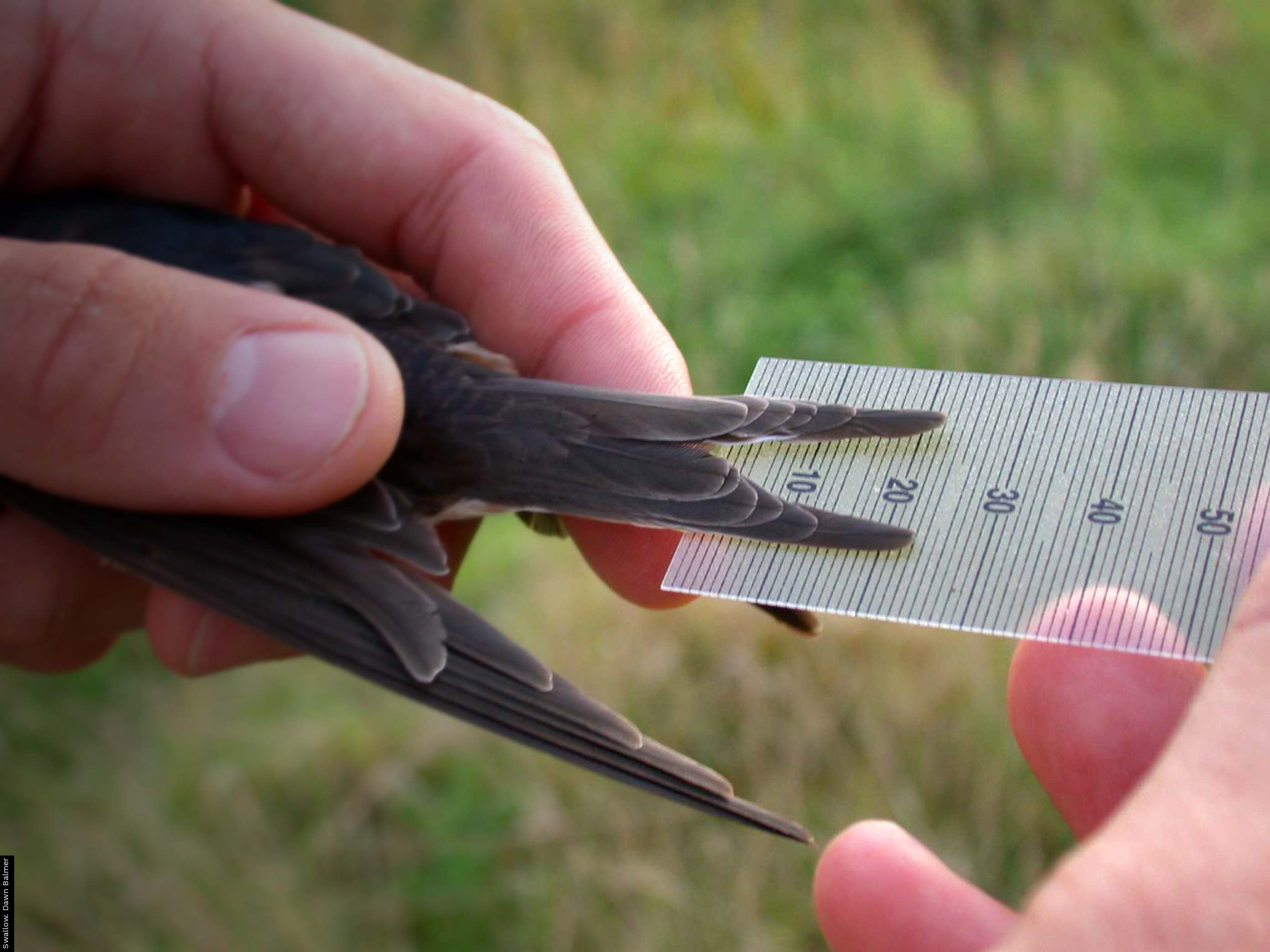Overview of licensing
- Why ring?
- Why nest record?
- How is bird ringing and nest recording licensed?
- Guidance and training
- How does ringing training and progression work?
- Further reading
- Additional useful information for ringers
Why ring?
When organised bird ringing began in Britain & Ireland in 1909, the focus was to learn more about where birds moved to and from, particularly on migration. While data from metal rings can still provide valuable information on the movements of birds, data gathered by ringers is increasingly used to monitor survival rates and breeding success of birds, allowing us to understand how environmental pressures, such as the development of land and climate change, influence their numbers. You can find out more about what we can learn from ringing birds here.
Why nest record?
The Nest Record Scheme (NRS) is the primary source of information on the timing of nesting and breeding success of birds in the UK. Volunteer nest recorders locate individual nests and record the contents at key intervals during the breeding season. The data collected allow the average number of chicks reared at each nesting attempt to be calculated, and this information about productivity is used in conjunction with survival data generated by ringing to establish which environmental pressures are responsible for driving changes in bird numbers. You can find out more about NRS results and publications here.
How is bird ringing and nest recording licensed?
Organisational licences and ringing permits
Every year BTO is issued Organisational Licences from the Statutory Nature Conservation Bodies (SNCBs) in England (Natural England), Scotland (NatureScot), Wales (Natural Resources Wales) and Northern Ireland (Northern Ireland Environment Agency, NIEA). These licences enable BTO to issue permits that allow ringers to catch (legally defined as ‘take’) wild birds in order to either fit BTO metal rings, produced to standard specifications by the manufacturing company Porzana, or to read rings previously fitted to recaptured birds; without licencing, this activity would be in contravention of the Wildlife & Countryside Act (1981, as amended). In the Republic of Ireland and in the Isle of Man, ringers must also apply directly to the relevant authorities (National Parks & Wildlife Service, NPWS, and The Department of Environment, Food & Agriculture respectively), using their BTO permit as evidence of their experience and competencies.
The Organisational Licences received from the SNCBs set out the conditions that BTO must meet to operate under them; BTO communicates equivalent conditions to ringers on issue of their permits. More detailed information is also provided via a range of supplementary guidance materials accessible to all permit holders, which are currently being migrated from paper to electronic formats. Ringing permits are renewed annually once it has been confirmed that the data collected under them during the previous 12 months has been submitted to BTO for processing and analysis.
Nest recording and Schedule 1 licensing
The Organisational Licences issued by the SNCBs, also allow BTO to issue permits in England and Scotland that allow holders to disturb Schedule 1 species during the breeding season for the purposes of ringing and nest recording. In Wales, licences are applied for via the BTO and issued directly by Natural Resources Wales on the basis of information on licence returns provided by volunteers to BTO. As with ringing permits, Schedule 1 licences are renewed annually once it has been confirmed that data collected under them during the previous 12 months has been submitted to BTO, or an alternative repository formally recognised by the SNCBs, for processing. BTO are not involved in equivalent processes operating in the Isle of Man, Northern Ireland or the Republic of Ireland. You can find out more about Schedule 1 species and related licensing here.
No licensing is required to monitor nests of non-Schedule 1 species in England, Wales, Scotland or the Isle of Man. All nest monitoring in Northern Ireland and the Republic of Ireland does require additional licensing to permit disturbance, which is administered by NIEA and NPWS respectively. Volunteers wishing to monitor nests under the auspices of the Nest Record Scheme must formally register with BTO and follow the guidance laid out in the NRS Code of Conduct.
Special Methods permissions
The SNCB Organisational Licences also enable ringing permit holders to catch birds for the purposes of fitting or retrieving devices other than BTO metal rings, such as colour rings and satellite tags, to employ marks such as dyes on plumage and to take a limited range of non-invasive samples; these activities are collectively referred to as ‘Special Methods’. BTO work in liaison with the Home Office to ensure that the impacts of any Special Method deployed fall below the ‘lower threshold’, as defined in the Animal (Scientific Procedures) Act 1986 (as amended).
The Home Office has agreed that a subset of established techniques, where risks of impact are very low, including colour ringing, use of plumage dyes and some sampling, can be approved by BTO staff on the basis of agreed methodological and training protocols. Ringers wishing to use higher risk Special Methods, including all tagging that employs harnesses, must, under the rules of the Ringing Scheme, apply to the Special Methods Technical Panel (SMTP) for permission, giving a detailed account of the method and techniques to be used and the purpose of the project. The SMTP, convened by BTO staff, is made up of tagging experts and at least one vet, all of whom contribute in a voluntary capacity. The panel liaises with the Home Office on a regular basis to ensure that the decisions made are in line with the latest Government interpretation of the legislation.
SMTP will reject applications if they have serious concerns about welfare impacts but, given best practice is now well established for many Special Methods, a more typical scenario would be for the panel to enter into a dialogue with the applicant to fine-tune the methodology. Any approval arising will outline the equipment and techniques that must be used, as well as the species, number, age and sex of birds to be marked, details that the applicant must then adhere to. Once permission to proceed with a project is approved, progress is reviewed on an annual basis to make sure that it continues to meet the required welfare standards. BTO/SMTP also consider Special Methods applications from BTO ringers operating outside the UK but the outcome of considerations is then passed by the ringer to the appropriate Government authority for official ratification. Further information on the licensing of Special Methods can be found here.
Guidance and training
The opportunity to train to ring birds is open to any member of the public. BTO provide guidance materials to all ringers on registration, traditionally via a hard-copy manual but increasingly through digital formats. This guidance outlines the licensing processes summarised above, data submission protocols and fundamental fieldwork principles, such as the basic details of approved catching techniques, how to fit rings, which data to record and how to collect it in a standardised manner. Best practice methodology is, however, highly situation-dependent, relating to the species being targeted, the method used, the type of site and the conditions in which the ringer is operating. While the BTO guidance identifies factors that need to be taken into account, the details of how this should be achieved are primarily conveyed through in-person training by experienced volunteer ringing Trainers, who have progressed through a peer-review system. Ringers are also directed to published resources in the public domain, some of which are listed in the table at the bottom of this page.
All those registering for the Ringing Scheme must, at the outset, identify a Trainer who is prepared to manage their development; the BTO’s Find-a-Trainer map provides a route for potential trainees to contact Trainers in their area, and can be accessed by following the instructions here. There is no obligation for anyone to provide training and many Trainers ask new recruits to attend taster sessions before committing to do so.
Ringers applying to the SMTP to use Special Methods are also obliged to indicate who will provide them with appropriate training; the suitability of the Trainer, in terms of relevant experience, is then assessed by the SMTP at the same time as the technical details of the project.
Anyone can apply to take part in the Nest Record Scheme and new participants can register online here. Registered nest recorders are provided with guidance conveying the basic principles of monitoring nests without influencing their outcome as well as being given access to the Find-a-Mentor map, enabling them to locate a Nest Record Mentor in their area. Mentoring is not mandatory but we advise anyone who is unsure of best practice to seek expert advice before proceeding with fieldwork.
How does ringing training and progression work?
The Ringing Scheme operates a modular permit system, whereby ringers are issued with one or more endorsements that indicate the catching method(s) (e.g. nestling ringing, mist net, whoosh net) that they have gained sufficient experience of using to be able to operate without direct supervision in order to catch birds of the specified taxonomic group(s) (e.g. passerines, waders, raptors). Restrictions may be placed on endorsements to further limit the range of species within each taxonomic group that the permit holder is able to target while unsupervised; these restrictions are managed by the Trainer.
On registration, a new ringer is issued with a T (Trainee) permit which has no associated endorsements. Under Ringing Scheme rules, a T-permit holder must only operate under the direct supervision of a ringing Trainer (S-permit holder) or another experienced ringer formally qualified to supervise Trainees. Gaining an endorsement usually takes a minimum of a year but this period can be highly variable, depending on the natural aptitude of the individual, the complexity of the method and the frequency with which they are able to train. Once the trainee has achieved a minimum level of experience defined by the BTO as acceptable for consideration, the Trainer may put them forward for their first endorsement(s) but is under no obligation to do so and, unless the candidate possesses transferable skills, is likely to insist on further training. All endorsements involving complex catching techniques capable of targeting multiple birds simultaneously (e.g. mist and whoosh nets) require formal assessment from a second, independent Trainer, whose report is considered by an expert panel of experienced ringers; the Ringing Standards Select Committee, which decides whether the endorsement is issued or the application is rejected.
Once a T-permit holder has gained their first endorsement, they are upgraded to a C-permit holder and can undertake activities pertaining to the endorsements they hold without direct supervision. Activities of C-permit holders are still overseen by a Trainer, who can support them in the acquisition of further endorsements via the process outlined above. Once the Trainer is satisfied that the C-permit holder is sufficiently competent to manage their endorsement restrictions, own their own rings and submit the data arising to BTO, they can apply for an A permit. Acquisition of further endorsements at this stage follows the same assessment processes as for a C-permit holder, outlined above, but the support of a Trainer is no longer required. A-permit holders are also eligible to upgrade to an S permit and become Trainers themselves, a process which again requires formal assessment by an independent Trainer.
You can find out more information about training to ring on our FAQs page.
Further reading
If you are interested in finding out more about ringing and specific projects that ringers and nest recorders undertake, you can read previous editions of LifeCycle magazine on our website.
Listed below are some of the publicly available resources related to ringing and nest recording. Please note that some of these publications may currently be out of print.
|
Name |
Summary |
|
Hardey, J. et al. (2014) Raptors- A field guide for Surveys and Monitoring. Scottish Natural Heritage, Edinburgh. |
Information on surveying raptors which breed in the UK. |
|
Ferguson-Lees, J. et al. (2011) A Field Guide to Monitoring Nests. British Trust for Ornithology, Thetford. |
Information on the breeding habits of birds found in the UK, including guidance on how to find nests and record them |
|
Demongin, L. (2016) Identification Guide to Birds in the Hand. Laurent Demongin. |
Moult, ageing and sexing of passerines and non-passerines |
|
Svensson, L. (2023) Identification Guide to European Passerines. British Trust for Ornithology, Thetford. |
Moult, ageing and sexing of passerines |
|
Baker, J. (2016) Identification of European Non-Passerines. British Trust for Ornithology, Thetford. |
Moult, ageing and sexing of non-passerines |
|
Jenni, L. and Winkler, R. (2020) Moult and Ageing of European Passerines. Bloomsbury, London |
Moult, ageing and sexing of passerines |
|
Balmer, D. et al. (2008) Bird Ringing- A Concise Guide. British Trust for Ornithology, Thetford. |
A general introduction to ringing |
|
Kenward, R.E. (2001) A Manual For Wildlife Radio Tagging. Academic Press, London. |
Some of the information is out of date as the technology has moved on, but contains useful information on the methodology of tagging and radio tracking, including on attachment types and analysis of results. |
|
BTO Ringing and Nest Recording Team (2023) A Field Reference Guide for Ringing and Nest Recording. British Trust for Ornithology, Thetford. |
A guide containing information for those involved in ringing monitoring nests. |
|
Ringing and NRS info app |
A free app which lists which ring sizes for each bird, biometric information, protected status by country, restrictions on ringing. |
Additional useful information for ringers
|
Ringing & Migration (BTO journal) |
|
Ringers’ Digiguide (ageing and sexing resource) |










Share this page